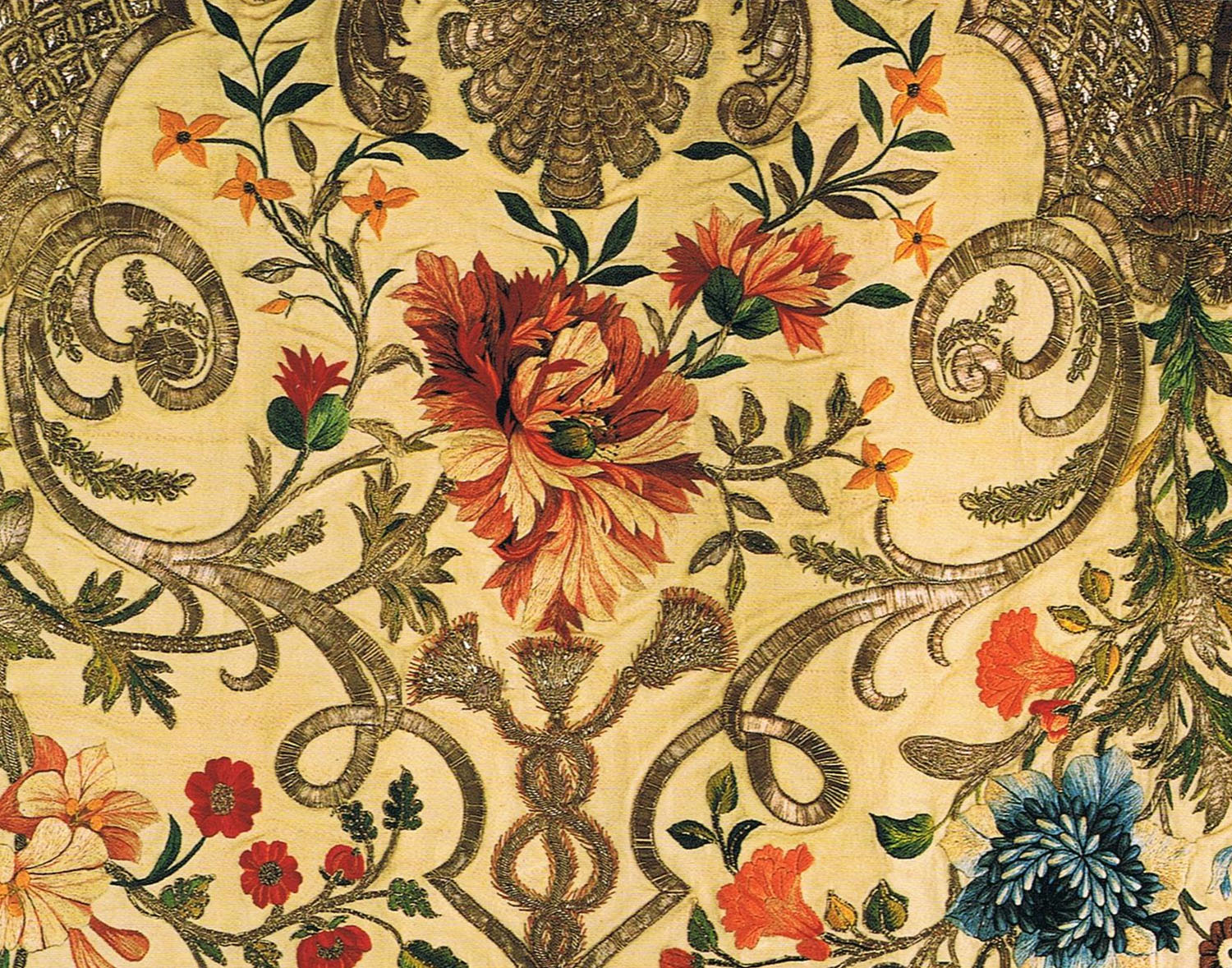Finals are rearing their ugly heads, and through review of my portfolio I again have found an essay quite fitting to the topics of Livre de la Mode. This also plays well with a biography I read over the summer, Antonia Fraser’s Marie Antoinette: The Journey. The subject has always been a huge interest of mine, and I have continually viewed Coppola’s film (largely based on the queen) to be a huge artistic tour de force in its own right.
NOTE: The report has been edited to fit Livre de la Mode’s posting style, as well as for length.

Prior to the 18th century, many simple silk industries thrived throughout multiple nations, seeing acclaim in a variety of worldwide fashions, be it clothing, furniture, or art-forms. The second half of the 1700s, however, introduced something new, something dynamic—the ideology of factories in all modes of design. This moment in time demonstrates obvious innovations leading to industrialism and automated mechanization within the silk industry.
While a multitude of people impact France’s silk industry at this time, few bring forth techniques eliciting a shift towards manufacturing as well as an enduring design influence. The man credited with the creation of the automated loom has a largely undocumented life despite his accomplishment. Jacques de Vaucanson created this loom following his appointment as silk manufacturer in 1741. More commemorated is Joseph-Marie Jacquard, whose experimentation with Vaucanson’s loom began following the French Revolution. Vaucanson’s experiments transitioned into the patented draw-loom of 1801. Specifically, this innovative work allowed for more efficiency in patterned weavings, which he developed further into the Jacquard loom of 1804. It must be noted that while the Jacquard’s innovations weren’t implemented during the studied period, the fact that he closed the eighteenth century with them provides a strong statement of French connotation prior to the revolution—specifically the government, the monarchy, or the industry itself.

The next figurehead examined is, again, one who’s work fits not into the studied time but allows for a dynamic influence of it. Lesley Ellis Miller provides a short overview of Jean Revel’s life in one of her many articles on the topic of silk, stating that his production work is first noted in the 1730s, through the production of metal yarns for silks. Eventually this transitioned into using gold and silver to create yarn and threading. Interestingly enough, because the production involved these precious metals, registry into the silk-weaving guild was unnecessary. This point of his career is not what makes him known, however. The creation of point rentré allowed for innovation in further stylized design in silk. Obviously, this change opened the door to many new naturalistic designs, paving the way for further designers of the period.
Gordon Campbell explains the breakthrough of point rentré, as it, “enabled a subtle gradation of colour to be achieved by interlocking the threads of adjacent colours. This meant that silks could be woven with naturalistic patterns, realistically shaded, that gave a three-dimensional impression.”

In regards to silk design, Philippe de Lasalle ran with the Revel’s industry innovations. Experimenting with Revel’s various shading processes, Lasalle also began incorporating a variety of other materials. Additionally, he even began adding paint to the surface of the silks in some designs. Although the bulk of Lasalle’s designs followed Revel’s naturalistic styles, he eventually moved to an individualized style in his own right. As time went on, he began creating silk portraiture, creating vast popularity among the elite, notably Madame de Pompadour. In terms of manufacturing, Lasalle created the semple. Melinda Watt explains it’s use and importance in the following boxed quote.
“The semple was a key part of the [loom] mechanism that controlled the pattern woven on the individual loom. Lasalle’s device could be transferred from one loom to another, without having to program the pattern a second time. The removable semple also facilitated the weaving of larger designs intended as wall coverings […].”
While many scholarly texts specifically regard Lasalle as a renaissance man of sorts, it seems quite plausible to add that title to any of the mentioned inventors of the silk industry at this time. Jean Revel consistently was torn with which title to call himself, artist, weaver, or entrepreneur. Jacquard’s loom innovations have brought industries, now namely the fashion industry, a style dedicated to his namesake. While some names have been forgotten, their movement towards the industrialism of the nineteenth century has not.

References
“Joseph-Marie Jacquard.” The Grove Encyclopedia of Decorative Arts. Gordon Campbell. Vol. 1. Oxford: Oxford University Press, 2006. Google Books. Web. 17 Nov. 2014.
Miller, Lesley Ellis. “The Marriage of Art and Commerce: Philippe de Lasalle’s Success in Silk.” Art History. 28.2 (2005): 200-226. Wiley Online Library. Web. 17 Nov. 2014.
Miller, Lesley Ellis. “A Portrait of the ‘Raphael of Silk Design.” Victoria & Albert Online Journal 4 (2012). Victoria & Albert Museum. Web. 8 Nov. 2014.
“On Jacques De Vaucanson and His Duck.” Anglophones Magazine. 1 Jan. 1999. Print.
“Silk.” The Grove Encyclopedia of Decorative Arts. Gordon Campbell. Vol. 2. Oxford: Oxford University Press, 2006. Google Books. Web. 2. Dec. 2014.
Watt, Melinda. “Textile Production in Europe: Silk, 1600-1800.” The Metropolitan Museum of Art. The Metropolitan Museum of Art, n.d. Web. 16 Nov. 2014.
Photo References
Trouvais Post: Antique Fabric, Sample Books
Computer History Museum sample, courtesy of Victoria & Albert Museum
